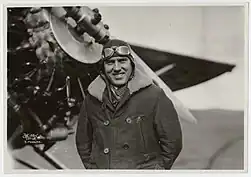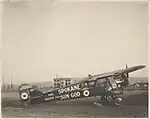Nick Mamer
Nicholas Bernard Mamer (1897 – January 10, 1938) was a noted American aviation pioneer and pilot in the Pacific Northwest during the 1920s and 1930s.[1][2][3]
Nick Mamer | |
|---|---|
 Mamer in March 1929 | |
| Born | Nicholas Bernard Mamer c. 1897 |
| Died | January 10, 1938 (age 40) |
| Cause of death | Plane crash, Northwest Flight 2 |
| Resting place | Evergreen Washelli Memorial Park Seattle, Washington |
| Occupation | Aviator |
| Spouse(s) | Faye C. Carey Mamer (1901–1958) (m.1925–1938, his death) |
| Children | Patricia Ann Mamer Lee (1927–1995) |
| Military career | |
| Allegiance | |
| Service/ | |
| Years of service | 1917–1919 |
| Unit | |
| Battles/wars | World War I |
Early career
Mamer learned to fly in San Diego and served with the Aviation Section, U.S. Signal Corps of the United States Army during World War I. He later settled in Spokane, Washington, establishing the Mamer Flying Service and Mamer Air Transport firms at Parkwater airstrip, renamed Felts Field in 1927. Mamer was a flight instructor and charter pilot, and was involved in early forest fire patrol flights for the U.S. Forest Service. Among his flight pupils was Bob Johnson, a well-known aviation pioneer in Missoula, Montana.
Spokane Sun-God

at Felts Field in 1929
Mamer is perhaps best remembered for undertaking a pioneering long-distance endurance flight in 1929 that began on August 15. The flight utilized a Buhl Airsedan biplane named the Spokane Sun-God; Mamer was at the controls, and was accompanied by Art Walker acting as mechanic and refueling hoseman.[4][5]
Beginning in Spokane, Mamer and Walker flew south to San Francisco, east to New York City, and back to Spokane five days later, without intermediate stops. Aerial refueling was accomplished at a number of points along the flight path (one was over Missoula on the return trip). Mamer and Walker did not sleep during those five days (120 hours) aloft. They set a number of records, one of which was a world's record non-stop flight of 7,200 miles (11,600 km).[6][7][8][9]
Death
By the late 1930s, Mamer had flown over a million miles (1.6 million km) and had relocated to Seattle; he was employed by Northwest Airlines, working as a pilot on the Seattle-Minneapolis route. In early 1938, he was at the controls of Flight 2, a Lockheed Super Electra, when the plane crashed in Montana on the afternoon of January 10.[10][11]
Parts of the tail section were torn from the aircraft as it flew over the Bridger Range, in Gallatin County northeast of Bozeman, and the plane went into a dive and crashed. Mamer, co-pilot Fred West, and eight passengers died instantly, and a fire ensued.[10][11] [12][13] Later, an investigation revealed that the tail structure had failed on the new design from what is known as "natural resonance, or period of vibration". It was the first fatal accident for the Super Electra and Northwest Airlines.
See also
References
- "Nick Mamer, pilot of huge liner, known to Lewiston friends as one of pioneers in West air service". Lewiston Morning Tribune. (Idaho). January 11, 1938. p. 2.
- "Famous air pilot lost with ship". Spokesman-Review. (Spokane, Washington). (photo). January 11, 1938. p. 1.
- ""We are over the peak -- nothing worries us now"". Spokane Daily Chronicle. (Washington). January 11, 1938. p. 6.
- "Spokane Sun-God flight all set". Spokesman-Review. (Spokane, Washington). August 15, 1929. p. 1.
- "Sun-God ready to soar". Spokane Daily Chronicle. (Washington). August 15, 1929. p. 1.
- "Sun God is ordered to land". Spokane Daily Chronicle. (Washington). August 20, 1929. p. 1.
- "10,000 citizens cheer daring Sun-God aviators' return to Spokane". Spokesman-Review. (Seattle, Washington). August 21, 1929. p. 1.
- "Sun God aviators appear in parade". Spokane Daily Chronicle. (Washington). August 21, 1929. p. 1.
- "Fliers span continent twice on non-stop hop". Reading Eagle. (Pennsylvania). Associated Press. August 21, 1929. p. 1.
- "Airliner crashes northeast of Bozeman killing 10, including Nick Mamer, veteran aviator". Lewiston Morning Tribune. (Idaho). Associated Press. January 11, 1938. p. 1.
- Hanlon, William (January 11, 1938). "Ten killed when airliner crashes in Montana during blizzard over mountains". Bend Bulletin. (Oregon). United Press. p. 1.
- Hanlon, William (January 12, 1938). "Bodies of plane wreck victims brought from Montana mountains". Bend Bulletin. (Oregon). United Press. p. 1.
- "Recover bodies from wreck". Lewiston Morning Tribune. (Idaho). Associated Press. January 12, 1938. p. 2.
External links
- Aerofiles: The flight of the Spokane Sun-God
- History Link.org – essay 8899
- Spokesman-Review – Then and Now: Pilot Nick Mamer
- Nick Mamer at Find a Grave